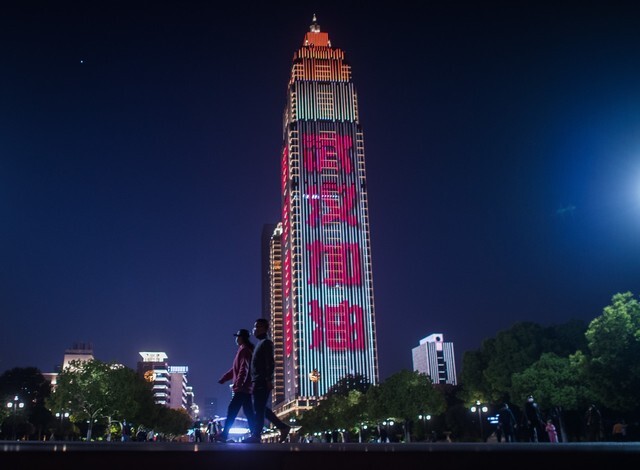hankyoreh
Links to other country sites 다른 나라 사이트 링크
[Column] Has China truly emerged “victorious” from its COVID-19 battle?

The chaos unfolding in the US and Europe due to the novel coronavirus pandemic has come as a shock to the rest of the world. Some analysts have been concluding that Western hegemony -- dating back more recently to the “unipolar” US-dominated system in the 30 years following the Cold War, and more generally to the 19th century -- may be coming to an end.
The leadership in the US has become a source of mockery -- symbolically illustrated by President Trump’s irresponsibility, a healthcare system that doesn’t serve the public, and the emergence of numerous COVID-19 patients on a US aircraft carrier, itself a symbol of military might. As the situation deteriorated, Trump’s first step was to ban arrivals from Europe; his next has been to denounce China and the World Health Organization (WHO). The US has treated its alliances like scrap paper, while forsaking any leadership role in triumphing over the crisis.
So does this mean the “China era” is at hand? Having brought the coronavirus’s spread under control, China has been lifting its lockdown on the epicenter in Wuhan and preparing to declare victory. China’s authorities have been shifting the focus from disease control to the economy. President Xi Jinping has emphasized the importance of restarting the economy with economic inspections and the like; local governments have been busily sending signals encouraging the public to “spend.”
Unreliability of Chinese statisticsBut China’s vaunting of victory appears to be premature. Fears of secondary infections continue, with a rise in cases arriving from its ally Russia. Other ongoing sources of concerns are the possibility of the virus’s spread being triggered anew by asymptomatic patients -- whom Chinese authorities only recently began managing separately after previously discounting them as a “low transmission risk” -- and the potential for local governments to cover up diagnosis numbers to avoid impeding the economic recovery. Underlying all of this are questions about the reliability of the Chinese government’s statistics. Many people have not been included in the numbers, having died without being diagnosed with or treated for COVID-19.
Anxiety and certainty are stumbling blocks to economic revival. Chinese authorities plan to increase the growth rate through large-scale investment in 5G and other areas. Production has been recovering at state-owned companies and other large-scale factories. But the question of how long the crisis will last in the major export markets of the US and Europe remains a factor. Many companies are left on the brink of bankruptcy by a full-scale nationwide shutdown that’s lasted for over two months; the situation has been ever more severe for SMEs and service businesses amid the reluctance of many to leave their homes or go out to eat.
Some analysts have pointed to a “frictional unemployment” situation, with around 200 million workers unable to return to their place of unemployment. Meanwhile, the roughly eight million young people graduating from university this year will also need to find jobs. It’s an awkward situation for the Chinese leadership, which has presented economic growth as an index for the legitimacy of Communist Party rule.
Wounds of Wuhan and Hubei province won’t heal quicklyThe situation also appears precarious in terms of popular sentiment, with many people suffering severely from the authorities’ early response failures. People had to sit and watch family members dying without receiving any treatment as they endured a 76-day lockdown; the anger, grief, and scars felt by the people of Wuhan and Hubei Province, who have faced discrimination since the lockdown was lifted, will not heal easily.
In global terms, China seems to be advancing to fill the geopolitical void left by the US’ turmoil. It is now working to build a narrative as a “contributor,” donating and selling masks and diagnostic kits and dispatching healthcare workers to around 120 countries. Meanwhile, a Chinese Foreign Ministry spokesperson trotted out a conspiracy theory claiming that the coronavirus was “spread by US soldiers,” and the Xinhua News Agency published a piece titled “Speak proudly: The world should thank China,” in which it claimed that China’s sacrifice had “saved the world.” This propaganda campaign to deflect accusations of China’s responsibility for the pandemic has been criticized as “brazen.”
Beijing missed out on a crucial opportunity when it could have contrasted its leadership capabilities with the chaos unfolding in the US. It could now face an even bigger challenge as the US and Europe hurry to overhaul the global supply network and pull factories from China after experiencing the side effects of over-concentrating their production bases there amid their difficulties acquiring face masks.
The significance of S. Korea as a new model of development and self-relianceWith all the apprehensions surrounding the “China model” and its efficiency through authoritarianism, people have turned their attention to the “South Korean model” as an alternative. If we ignore the baseless criticisms coming from conservative politicians and media, South Korea has definitely been seen globally as having responded effectively without sacrificing its economy thanks to its democratic methods and voluntary efforts by its public.
In a “G-Zero” era lacking leaders, South Korea stands at the starting block, poised to break free of its slavish following of the “great power” model and chart its own course. The reconfiguration of the world by the “coronavirus revolution” leaves us facing important responsibilities. It’s time for us to take another step forward in preparing for an economic and employment crisis, the decline of globalization and a restructuring of the global supply network, and to thoroughly consider and make preparations for a more fair and equal community. At the polling stations on Apr. 15, we need to ask the question: Who will be with us as we address those tasks?

By Park Min-hee, editorial writer
Please direct comments or questions to [english@hani.co.kr]

Editorial・opinion
![[Column] Season 2 of special prosecutor probe may be coming to Korea soon [Column] Season 2 of special prosecutor probe may be coming to Korea soon](https://flexible.img.hani.co.kr/flexible/normal/500/300/imgdb/original/2024/0426/3317141030699447.jpg) [Column] Season 2 of special prosecutor probe may be coming to Korea soon
[Column] Season 2 of special prosecutor probe may be coming to Korea soon![[Column] Park Geun-hye déjà vu in Yoon Suk-yeol [Column] Park Geun-hye déjà vu in Yoon Suk-yeol](https://flexible.img.hani.co.kr/flexible/normal/500/300/imgdb/original/2024/0424/651713945113788.jpg) [Column] Park Geun-hye déjà vu in Yoon Suk-yeol
[Column] Park Geun-hye déjà vu in Yoon Suk-yeol- [Editorial] New weight of N. Korea’s nuclear threats makes dialogue all the more urgent
- [Guest essay] The real reason Korea’s new right wants to dub Rhee a founding father
- [Column] ‘Choson’: Is it time we start referring to N. Korea in its own terms?
- [Editorial] Japan’s rewriting of history with Korea has gone too far
- [Column] The president’s questionable capacity for dialogue
- [Column] Are chaebol firms just pizza pies for families to divvy up as they please?
- [Column] Has Korea, too, crossed the Rubicon on China?
- [Correspondent’s column] In Japan’s alliance with US, echoes of its past alliances with UK
Most viewed articles
- 1AI is catching up with humans at a ‘shocking’ rate
- 2After election rout, Yoon’s left with 3 choices for dealing with the opposition
- 3Is Japan about to snatch control of Line messenger from Korea’s Naver?
- 4South Korea officially an aged society just 17 years after becoming aging society
- 51 in 5 unwed Korean women want child-free life, study shows
- 6[Column] ‘Choson’: Is it time we start referring to N. Korea in its own terms?
- 7Korea’s 1.3% growth in Q1 signals ‘textbook’ return to growth, says government
- 8No good, very bad game for Korea puts it out of Olympics for first time since 1988
- 9[Editorial] Japan’s rewriting of history with Korea has gone too far
- 10Why Korea shouldn’t welcome Japan’s newly beefed up defense cooperation with US